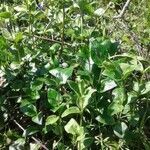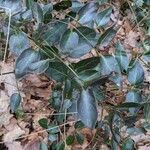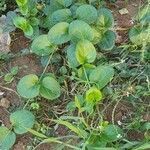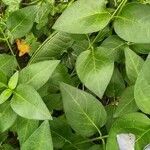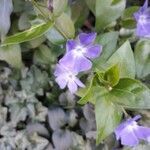Perennial, many-branched herb; stems 0.8-2.0 m long; flowering branches erect, vegetative branches trailing and rooting at nodes. Leaves ovate, ovate-lanceolate to subcordate, (30-)50-90 x 25-50 mm; ciliate. Inflorescences axillary and solitary. Flowers salver-shaped, blue. Corolla: tube 20 mm long, with hairs in throat; lobes 30-50 mm, obovate with very obtuse, almost truncate apex. Stamens inserted below throat; filaments short. Gynoecium apocarpous and bicarpellate. Styles: apex ovoid with annulus, tapering to an almost truncate apex. Flowering time Aug.-Apr. Fruit a pair of erect, diverging follicles, 30-50 mm long; seed without coma.
Perennial herb to 50 cm high. Leaves with lamina ovate or ±orbicular, 15–60 mm long, 14–45 mm wide, acute, cuneate, discolorous; secondary veins 4–6 each side of midrib; tertiary venation obscure. Flowers 20–28 mm long, 30–40 mm diam.; pedicels 15–33 mm long. Sepals linear, 12–15 mm long. Corolla lilac-blue to white; tube 16–17 mm long, c. 7 mm diam. at top, 3 mm diam. at base; lobes ovate-spathulate, 16–18 mm long, 8–15 mm wide. Stamens inserted c. 9 mm from top of tube. Fruit fusiform, 35–40 mm long, c. 4 mm diam.
Herbs to 1 m tall, flowering stems to 30 cm. Leaf blade elliptic, ovate, or broadly ovate, 2-9 X 2-6 cm, base truncate or subcordate, margin ciliate with hairs 0.1-1 mm; lateral veins to 5 pairs. Pedicel 3-5 cm. Sepals narrowly triangular, ca. 9 mm, densely ciliate. Corolla bluish purple, tube 1.2-1.5 cm, limb 3-5 cm in diam., lobes obliquely truncate. Anthers short, applanate, apex puberulent. Follicles spreading, ca. 5 cm. Fl. Mar-May. 2n = 92.
A herb. It is a trailing plant. It grows 45 cm high and spreads 1.5-3 m wide. It keeps growing from year to year. It keeps its leaves. The stems are slender and leathery. The leaves are glossy and dark green. They can be patterned. The flowers are open and mauve or purple. They are wide and flat.
More robust than no. 1 [Vinca minor L.], the flowering branches to 5 dm tall; lvs deltoid-ovate, 3–7 cm, ciliate; cor-tube 12–20 mm, the limb 3.5–5 cm wide; 2n=92. Native of s. Europe, occasionally escaped in s. U.S., n. to Va. and Ill. Apr., May.
